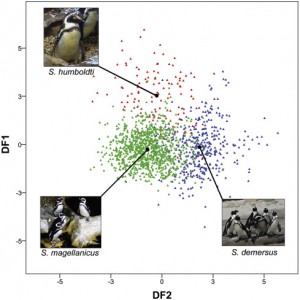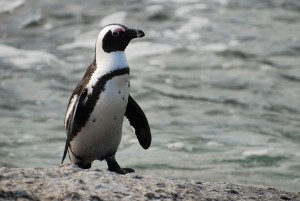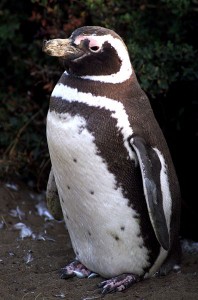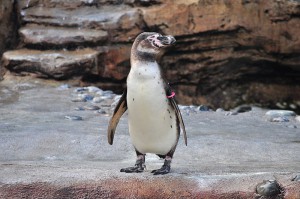Michael Kim
Penguins can Introduce Themselves as Well: Vocal Individuality in Penguin Contact Calls
Communication plays a pivotal role in all living species. Functions of communication can span from signaling for detection to displaying complex mating vocalizations.Vocalizations of bird species have garnered much attention in scientific literature due to its important in communication. Vocal signaling both within and outside of species groups have important uses as social tools, and mechanisms for mating and territory defense. Much research has gone into analyzing the structure of various bird species’ vocalizations and the information they carry. However, much of this research has focused on display songs for mating and agonistic calls made in fights and territory defense. Not as much research has been done on contact calls, which are important for social group coherence as well as containing information about the identity of the call sender. One study by Favaro et al. (2016) aimed to further explore the contact calls of three colonies of penguins and to see if they encoded identity information about the penguins.
Studies have shown that the African penguin uses contact calls to encode individual identity information and allows individual discrimination. The Favaro et al. (2016) study tested whether these contact call vocalizations allowed individual discrimination in two other penguin species that are allopatrically related to the African penguin. Birdcalls are generated by vibrations of membranes in the syrinx, which is also known as the “source” that determines fundamental frequency of the call. These calls are subsequently filtered by the suprasyringeal vocal tract, which is also known as the “filter” that results in amplified frequencies. This two-step process is known as the source-filter theory of vocal production and has recently been shown to be useful in gaining a better understanding of individual identity information contained in vocalizations. Following this source-filter approach, the researchers of this study wanted to determine whether the contact calls of two penguin species (Magellanic and Humboldt penguins) have the potential to allow individual discrimination of the callers. They also wanted to test whether the acoustic features of contact calls have diverged across this genus, and so they compared calls of Magellanic and Humboldt penguins (sympatric species that potentially interbreed) to the African penguin, which is allopatric (geographically isolated). The researchers hypothesized that contact calls of these penguins would allow individual discrimination using both source and filter related components, and that contact calls can be classified according to species.
By Paul Mannix – African penguin, near Boulders Beach, South Africa, CC BY-SA 2.0, https://commons.wikimedia.org/w/index.php?curid=2626774
Magellanic penguin near Punta Arena, Chile, photographed in its natural summer habitat during NASA’s AirSAR 2004 campaign, March 13, 2004. Jim Ross.
https://commons.wikimedia.org/wiki/File:Magellanic-penguin.jpg
Humboldt Penguin, Woodland Park Zoo, Seattle, Washington, USA by Joe Mabel.
https://commons.wikimedia.org/wiki/File:WPZ_-_Humboldt_Penguin_05.jpg
The study used subjects from the three species of penguins and recorded their vocalizations using a microphone connected to a digital recorder. These vocalizations were subsequently analyzed using narrow-band spectrograms, and a series of spectral and temporal parameters that are important to vocal distinctiveness were also measured (including call duration, source-related features, and filter-related features). Using these source and filter vocal parameters, analysis correctly classified 70% of the contact calls to the emitter for Magellanic penguins and 60.5% for Humboldt penguins. Overall, the results showed that individual identity is encoded in contact calls of both Magellanic and Humboldt penguins, and that both source and filter related components have the potential to encode individual identity information like they hypothesized. In addition, calls were correctly classified to the correct species in 88.8% of cases suggesting discrimination abilities of contact calls at the individual and species level (Figure 1, Favaro et al. 2016). This finding of correct species recognition was observed based on eight acoustic parameters that significantly differed among the three species.

Figure 1. Discriminant scores generated by the discriminant functions 1 and 2 to classify contact calls of African, Humboldt, and Magellanic penguins. Results suggested that the contact calls of the three species form distinctive clusters in space, as defined by discriminant functions 1 and 2.
The findings of this study supported their hypotheses that penguin contact calls encode individual identity information and species-specific acoustic signatures using both source and filter related components. Overall these results provided more evidence that the source-filter theory of vocal production can be successfully applied to the interpretation of information contained in bird vocalizations (Favaro et al., 2016). These results are important when looked at within the context of penguin lifestyles. Since penguins often form flocks at sea for travelling and foraging, they produce contact calls to maintain group cohesion as well as for their highly synchronized diving behavior. When these penguins are underwater and get out of contact with other group members in large flocks, they can surface asynchronously. In order to combat this, penguins call to locate other group members when out of sight. When the effective distance and transmission of visual signals are worse compared to vocalizations, there will be selective pressure for vocal individuality. This is an interesting phenomenon because it suggests that the signaling of these penguins is heavily influenced by environmental factors and also depends on how well their particular environments suit certain signals over others. Related to the researchers’ aims of studying contact calls for individual and species discrimination is how the African, Magellanic and Humboldt penguins diverged as species. These three penguin species diverged in several spectral and temporal acoustic properties, and results showed that acoustic cues to species were also present in contact calls and are likely to depend on the anatomy of the vocal tract. The authors also suggested that species-specific vocalizations may prevent incorrect mate choice and lead to reproductive isolation and therefore divergence of species.
The implications of this study are far-reaching and support prior literature on bird vocalizations. The acoustic differences in both the sympatric and allopatric species of penguins suggests that the species-specific acoustic properties in contact calls is likely to be a by-product of divergent ecological selection. This study showed that anatomical differences of source and filter vocal components mediate individual and species recognition, and that these vocalizations are adaptations to travelling, foraging, and mating. While this study focused on sender signaling and the information it contained, future research into how receivers process this information is warranted. It would be interesting to see how salient these signals are to receiver penguins and how sensitive they are to acoustic cues. These follow up studies would provide us with a much more complete picture of bird vocalizations.
Source: Favaro, L., Gili, C., Da Rugna, C., Gnone, G., Fissore, C., Sanchez, D., McElligott, A., Gamba, M. and Pessani, D. (2016). Vocal individuality and species divergence in the contact calls of banded penguins. Behavioural Processes, 128, 83-88.



